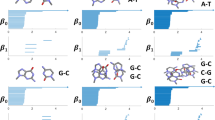Abstract
Enzymes are crucial in accelerating metabolic reactions in living organisms. Protoporphyrinogen oxidase (PpOI) is an enzyme that catalyses the production of protoporphyrin IX (PpIX), a protein used in a cancer treatment known as photodynamic therapy (PDT). In this study, a structure-function analysis of PpOI was carried out using the Resonant Recognition Model (RRM), a physico-mathematical approach for analysis of proteins interactions. This method is based on the finding that the distribution of delocalised electron energies along the protein plays a crucial role in determining the protein’s biological activity. Two digital signal processing (DSP) methods were used: Fourier Transform (FT) and Continuous Wavelet Transform (CWT). Here we have determined the characteristic frequencies and the “hot spot” amino acids, and predicted the location of proteins’ active site(s). Several proteins that potentially belong to the PpOI functional group were also analysed to distinguish their viability in this role.
Similar content being viewed by others
References
Cosic, I.,Macromolecular bioactivity — is it resonant interaction between macromolecules — theory and applications. IEEE Trans. on Biomed. Eng., 41(12): p. 1101–1114, 1994
Cosic, I.,The resonant recognition model of macromolecular bioactivity: Theory and applications., Melbourne: Springer & Verlag, 1997.
Macdonald, I. J., Dougherty, T. J.,Basic principles of photodynamic therapy. J. Porphyrins and Phthalocyanines, 5: p. 101–129, 2001.
Kennedy, J. C., Pottier, R. H.,Endogenous protoporphyrin ix, a clinically useful photosensitizer for photodynamic therapy. J. Photochem. Photobiol. B, 14: p. 275–292, 1992.
Martin, D. W.,Porphyrins and bile pigments, inHarper’s review of biochemistry, Martin D.W., Maynes, P.A., and V.W, R., Editors., Lange Medical Publications: Los Altos, CA. p. 331–347, 1985.
Wyld, L., Burn, J. L., Reed, M. W. R., Brown, N.,Factors affecting aminolaevulinic acid-induced generation of protoporphyrin ix. Br. J. Cancer, 76(6): p. 705–712, 1997.
Velikovic, I., Slavic M.,General model of pseudopotentials. Phys. Rev. Lett., 29: p. 105–108, 1972.
Cosic, I., Hodder, A. N., Aguilar, M. I., Hearn, M. T. W.,Resonant recognition model and protein topography — model studies with myoglobin, hemoglobin and lysozyme. Eur J Biochem, 198(1): p. 113–119, 1991.
Cosic, I.,Virtual spectroscopy for fun and profit Biotechnology, 13(3): p. 236–238, 1995.
Cosic, I., deTrad, C. H., Fang, Q., Akay, M.,Protein sequences analysis using the rrm model and wavelet transform methods: A comparative study, in IEEE-EMBS Asia Pacific Conf. Biomed Eng. p. 405–406, 2000.
Cosic, I., Hearn, M. T. W.,‘hot spot’ amino acid distribution in ha-ras oncogene product p21: Relationship to guanine binding site. J. Mol. Recog., 4: p. 57–46, 1991.
Cosic, I., Pavlovic, M., Vojisavljevic, V.,Prediction of hot spots in interleukin-2 based on informational spectrum characteristics of growth-regulating factors — comparison with experimental-data. Biochimie, 71(3): p. 333–342, 1989.
Akay, M.,Time frequency and wavelets in biological signal processing., Piscataway, NJ: IEEE press, 1998.
Barayani, L., Cosic, I., Campbell, W., Deretey, E., Deretey, V., Okada, N., Okada, H.,Antisense homology boxes coinicide with the ’hot spot’ regions predicted by resonant recognition theory. inProc. 2nd Intl Conf Bioelectromagn. 1998.
Cosic, I., Fang, Q., Pirogova, E.,Modification of the rrm model using wavelets transform and ionization constant to predict protein active sites. Proc. 21st Ann. Conf. IEEE EMBS, 21(2): p. 1215, 1999.
Fang, Q., Cosic, I.,Prediction of the active sites of the fibroblast growth factors using continuous wavelet transform and the resonant recognition model. Proc. Inaugural Conf. Victorian Chapter IEEE EMBS, p. 211–214, 1999.
ExPASy,http://kr.Expasy.Org/cgi-bin/niceprot.Pl?Q9l6l1.
ExPASy,http://kr.Expasy.Org/cgi-bin/niceprot.Pl?Q7mai5.
Pirogova, E., Akay M., Cosic I.,Investigation of the structural and functional relationship of oncogene proteins. Proceedings of the IEEE, 2002. 90(12): p. 1859–1867.
de Trad, C. H., Fang, Q., Cosic, I.,The resonant recognition model (rrm) predicts amino acid residues in highly conserved regions of the hormone prolactin (prl). Biophys Chem, 84(2): p. 149–157, 2000.
Author information
Authors and Affiliations
Corresponding author
Additional information
Presented at the Annual Engineering and Physical Sciences in Medicine Conference, Geelong, Victoria, Australia, 14–18 November 2004
Rights and permissions
About this article
Cite this article
Sauren, M., Pirogova, E. & Cosic, I. RRM analysis of protoporphyrinogen oxidase. Australas Phys Eng Sci Med 27, 174–179 (2004). https://doi.org/10.1007/BF03178646
Received:
Accepted:
Issue Date:
DOI: https://doi.org/10.1007/BF03178646




